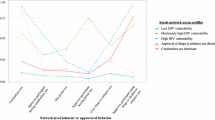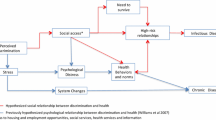Abstract
This study examined the effect of social network descriptive sexual norms and behaviors on the sexual behaviors of people who inject drugs (PWID). Data from HPTN037 of 232 PWID (egos) and 464 network members (alters) were used in multilevel multivariate logistic regression models. Egos whose alters reported multiple sex partners had greater odds of multiple sex partners (aOR 2.20, 1.13–4.29). Egos’ norms of condomless sex with primary (aOR 2.67, 1.15–6.17) and casual (aOR 2.38, 1.01–5.59) partners and egos’ norms of giving (aOR 5.52, 1.87–16.25) and receiving (aOR 7.38, 1.34–40.66) money/drugs for sex were associated with the egos’ respective behaviors. History of sex between an ego and alter was not associated with increased influence of alters’ norms and behaviors on egos’ sexual behavior. Findings provide support for developing interventions that target descriptive norms and selective network behavioral characteristics to decrease sexual HIV risk behavior among PWID.
Similar content being viewed by others
References
Centers for Disease Control and Prevention. HIV and injection drug use. https://www.cdc.gov/hiv/pdf/risk/cdc-hiv-idu-fact-sheet.pdf. Accessed February 23, 2018.
Copenhaver MM, Johnson BT, Lee IC, Harman JJ, Carey MP. Behavioral HIV risk reduction among people who inject drugs: meta-analytic evidence of efficacy. J Subst Abuse Treat. 2006;31(2):163–71.
Walter AW, Cheng DM, Lloyd-Travaglini CA, Samet JH, Bernstein J, Saitz R. Are decreases in drug use risk associated with reductions in HIV sex risk behaviors among adults in an urban hospital primary care setting? Prev Med Rep. 2016;4:410–6.
Valente TW. Social networks and health: models, methods, and applications. New York: Oxford University Press Inc; 2010.
Smith KP, Christakis NA. Social networks and health. Annu Rev Sociol. 2008;34:405–29.
Rhodes T, Singer M, Bourgois P, Friedman SR, Strathdee SA. The social structural production of HIV risk among injecting drug users. Soc Sci Med. 2005;61(5):1026–44.
Koram N, Liu H, Li J, Li J, Luo J, Nield J. Role of social network dimensions in the transition to injection drug use: actions speak louder than words. AIDS Behav. 2011;15(7):1579–88.
Lakon CM, Ennett ST, Norton EC. Mechanisms through which drug, sex partner, and friendship network characteristics relate to risky needle use among high risk youth and young adults. Soc Sci Med. 2006;63(9):2489–99.
Tsang MA, Schneider JA, Sypsa V, et al. Network characteristics of people who inject drugs within a new HIV epidemic following Austerity in Athens, Greece. J Acquir Immune Defic Syndr. 2015;69(4):499–508.
Latkin CA, Kuramoto SJ, Davey-Rothwell MA, Tobin KE. Social norms, social networks, and HIV risk behavior among injection drug users. AIDS Behav. 2010;14(5):1159–68.
De P, Cox J, Boivin JF, Platt RW, Jolly AM. The importance of social networks in their association to drug equipment sharing among injection drug users: a review. Addiction. 2007;102(11):1730–9.
Mulawa M, Yamanis TJ, Hill LM, Balvanz P, Kajula LJ, Maman S. Evidence of social network influence on multiple HIV risk behaviors and normative beliefs among young Tanzanian men. Soc Sci Med. 2016;153:35–43.
Smith LR, Strathdee SA, Metzger D, Latkin C. Evaluating network-level predictors of behavior change among injection networks enrolled in the HPTN 037 randomized controlled trial. Drug Alcohol Depend. 2017;175:164–70.
Perkins HW, Berkowitz AD. Perceiving the community norms of alcohol use among students: some research implications for campus alcohol education programming. Int J Addict. 1986;21(9–10):961–76.
Latkin C, Donnell D, Liu TY, Davey-Rothwell M, Celentano D, Metzger D. The dynamic relationship between social norms and behaviors: the results of an HIV prevention network intervention for injection drug users. Addiction. 2013;108(5):934–43.
Ridout B, Campbell A. Using Facebook to deliver a social norm intervention to reduce problem drinking at university. Drug Alcohol Rev. 2014;33(6):667–73.
Tobin K, Davey-Rothwell M, Latkin C. Social-level correlates of shooting gallery attendance: a focus on networks and norms. AIDS Behav. 2010;14(5):1142–8.
Davey-Rothwell MA, Latkin CA. HIV-related communication and perceived norms: an analysis of the connection among injection drug users. AIDS Educ Prev. 2007;19(4):298–309.
Davey-Rothwell MA, Latkin CA. Gender differences in social network influence among injection drug users: perceived norms and needle sharing. J Urban Health. 2007;84(5):691–703.
National Drug Early Warning System. Philadelphia Sentinel Community Site (SCS) Drug Use Patterns and Trends, 2017. https://ndews.umd.edu/sites/ndews.umd.edu/files/philadelphia-scs-drug-use-patterns-and-trends-2017-final.pdf. Accessed November 21, 2018.
Centers for Disease Control and Prevention. HIV Surveillance Report, 2017; vol. 29. http://www.cdc.gov/hiv/library/reports/hiv-surveillance.html. Published November 2018. Accessed November 21, 2018.
Latkin CA, Donnell D, Metzger D, et al. The efficacy of a network intervention to reduce HIV risk behaviors among drug users and risk partners in Chiang Mai, Thailand and Philadelphia, USA. Soc Sci Med. 2009;68(4):740–8.
Van de Bongardt D, Reitz E, Sandfort T, Deković M. A meta-analysis of the relations between three types of peer norms and adolescent sexual behavior. Pers Soc Psychol Rev. 2015;19(3):203–34.
Jones J, Salazar LF, Crosby R. Contextual factors and sexual risk behaviors among young, black men. Am J Mens Health. 2017;11(3):508–17.
Kapadia F, Frye V, Bonner S, Emmanuel PJ, Samples CL, Latka MH. Perceived peer safer sex norms and sexual risk behaviors among substance-using Latino adolescents. AIDS Educ Prev. 2012;24(1):27–40.
Longshore D, Stein JA, Chin D. Pathways to sexual risk reduction: gender differences and strategies for intervention. AIDS Behav. 2006;10(1):93–104.
Huebner DM, Neilands TB, Rebchook GM, Kegeles SM. Sorting through chickens and eggs: a longitudinal examination of the associations between attitudes, norms, and sexual risk behavior. Health Psychol. 2011;30(1):110–8.
Barman-Adhikari A, Begun S, Rice E, Yoshioka-Maxwell A, Perez-Portillo A. Sociometric network structure and its association with methamphetamine use norms among homeless youth. Soc Sci Res. 2016;58:292–308.
Kelly JA, Amirkhanian YA, Seal DW, et al. Levels and predictors of sexual HIV risk in social networks of men who have sex with men in the midwest. AIDS Educ Prev. 2010;22(6):483–95.
Schneider JA, Cornwell B, Ostrow D, et al. Network mixing and network influences most linked to HIV infection and risk behavior in the HIV epidemic among black men who have sex with men. Am J Public Health. 2013;103(1):e28–36.
Adimora AA, Schoenbach VJ, Doherty IA. HIV and African Americans in the southern United States: sexual networks and social context. Sex Transm Dis. 2006;33(7 Suppl):S39–45.
Neblett RC, Davey-Rothwell M, Chander G, Latkin CA. Social network characteristics and HIV sexual risk behavior among urban african american women. J Urban Health. 2011;88(1):54–65.
Friedman SR, Bolyard M, Mateu-Gelabert P, et al. Some data-driven reflections on priorities in AIDS network research. AIDS Behav. 2007;11(5):641–51.
Rudolph AE, Linton S, Dyer TP, Latkin C. Individual, network, and neighborhood correlates of exchange sex among female non-injection drug users in Baltimore, MD (2005–2007). AIDS Behav. 2013;17(2):598–611.
Funding
Research reported in this publication was supported by the HIV Prevention Trials Network (HPTN) Scholars Program through the National Institute of Allergy and Infectious Disease of the National Institutes of Health (UM1AI068619) and through grants from the National Institute on Drug Abuse (NIDA; K01DA039767 and R01DA040488). The content is solely the responsibility of the authors and does not necessarily represent the official views of the National Institutes of Health. Research conducted in this publication was also partially supported by a Florida International University McNair Graduate Fellowship (Miller RP).
Author information
Authors and Affiliations
Corresponding author
Ethics declarations
Conflict of interest
The authors declare that they have no conflict of interest.
Ethical Approval
All procedures performed in studies involving human participants were in accordance with the ethical standards of the institutional and/or national research committee and with the 1964 Helsinki declaration and its later amendments or comparable ethical standards.
Informed Consent
Informed consent was obtained from all individual participants included in the study.
Additional information
Publisher's Note
Springer Nature remains neutral with regard to jurisdictional claims in published maps and institutional affiliations.
Rights and permissions
About this article
Cite this article
Sheehan, D.M., Miller, R.P., Trepka, M.J. et al. Role of Social Network Sexual Norms and Behaviors on the HIV Sexual Risk Behaviors of People Who Inject Drugs in HPTN 037. AIDS Behav 23, 1604–1611 (2019). https://doi.org/10.1007/s10461-019-02409-8
Published:
Issue Date:
DOI: https://doi.org/10.1007/s10461-019-02409-8




